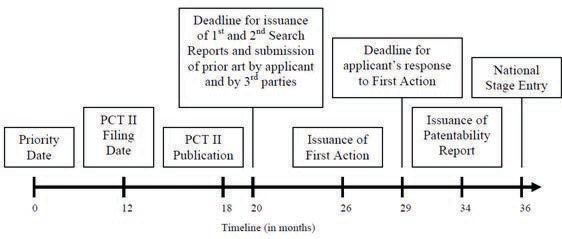
or

Idea. Asset. Patents. Globally, valuable utilization of Intellectual Assets hasbeen a challenge for the industry professionals to maze through and takecritical business decisions. However, harmonization of Patent Law alsoplays a major role in the whole value chain. This is a continuation of theseries that started in May 2015 by Pinaki Ghosh, AVP, IP Department,Reliance Industries Ltd., a vanguard in this domain. The next issue shall bethe concluding part of the series.
Aims marked with a tentative schedule forJanuary 2010 need immediate nationalaction. Other requirements need adiscussion with the member states alongwith various opinions.
Further contracting states and offices haveto seek to eliminate the inconsistenciesarising out of the reservations, notices,declarations and incompatibilities1 providedunder Article 64 of the PCT. Article 64(1)(a)provides that any State may declare itselfto not be bound by Chapter II (InternationalPreliminary Examination) of PCT. Variouscountries have opted for differentreservations, notices, declarations andincompatibilities of the PCT Articles andPCT Rules.

The PCT working group had held recentlyits second session at Geneva from May 4,2009 to May 9, 2009) where PCT/WG/2/12contains the proposal of PCT reform asproposed by the USPTO. The proposed PCTII system would, in brief have the followingfeatures:
The proposal by USPTO states that thenational patent grant would be like theinternational systems such as Hague.Currently, in the Hague System, upon aninternational grant, the national officeshave a period of about six months tooppose/refuse the registration of theapplication. It is assumed that there is apossibility of bringing in a parallel systemunder the PCT II.
Knowledge today is the fundamental driverof sustainable competitive andcollaborative advantage. Innovation can bedefined as the outcome of a set of activitiesthat use knowledge to create new value tothose benefiting from its use.5 Sustainableinnovation can only be assured throughboth competitive and collaborativeadvantage. In order to incorporate externalcapabilities and knowledge into acompany’s innovation process, theorganization needs to be adaptive and openfor change. Innovation can be of two types– Open and Closed.
Open innovation is a paradigm thatassumes that firms can and should useexternal and internal ideas, and externaland internal paths to market. The OpenInnovation model can be compared withthe traditional, closed model in whichenterprises generate, develop and markettheir own ideas, usually organized in aninternal R&D department. This closedmodel has become outdated due toincreased mobility of workers, bettereducation, and growing presence of venturecapital, increasingly shortened product lifecycles, growing competition, and wideavailability of knowledge from multiplesources. 6The reason for open innovation isto make the R&D more productive. Openinnovation is not limited to a firm level. Ina closed innovation system, efforts forinnovation are within the firm. It ispracticed within the context of a given setof political and economic institutions,including regulations, intellectual property(IP) law and industry structure.
Open innovation implies that valuable ideascan come from inside or outside theorganization, but also that these ideas canbe marketed via internal or externalpathways. As a result of these in- andoutflows of ideas, intellectual property (IP)plays a crucial role in Open Innovation. Inthe closed paradigm enterprises wouldcontrol their Intellectual Property (IP) insuch a way that competitors could notbenefit. Prior theories of innovation treatedIntellectual Property (IP) as a byproduct ofinnovation, and its use was primarilydefensive. This would enable enterprises topractice their internal technologies withoutbeing blocked or held up by external IP,and to prevent their rivals from benefitingfrom their innovative efforts.In the open model enterprises manage theirIntellectual Property (IP) proactively. Theyneed to access external IntellectualProperty (IP) to speed up and nurture theirown research engine. At the same time,they also profit from their own, unused Intellectual Property (IP) when otherenterprises with different business modelsfind profitable, external paths to the marketfor ideas.
The open innovation trend is driven up twomajor factors, globalization and increasingcompetitive pressure and reduction ofproduct life-cycles demand quickerinnovation processes at a reduced cost.Diversification along with verticalintegration from research and developmentthrough distribution can provide firms withcompetitive advantage over smaller andnewer rivals through economies of scaleand scope. 8As collaboration has beenadvanced in otherindustries in differentbusiness activities throughparticipation in platformsknown as innovationplatforms, one of which isopen innovation platformswhich can function withinor even outside a nation.Collaboration has beendiversified throughassociations with industrialpartners as well asacademic representatives.Under the given scenario,following articles of theTRIPS play a role in thetechnology transactionsbetween nations (firm tofirm, firm to governmentetc). The objectives ofTRIPS are set down inArticle 7 states:
“The protection andenforcement of intellectualproperty rights shouldcontribute to thepromotion of technologicalinnovation and to the transfer and disseminationof technology to the mutual advantage ofproducers and users of technologicalknowledge and in a manner conducive tosocial and economic welfare, and to abalance of rights and obligations.”
“Appropriate measures, provided they areconsistent with the provisions of theAgreement, may be needed to prevent theabuse of intellectual property rights byright holders or the resort to practiceswhich unreasonably restrain trade oradversely affect the international transferof technology.
Pinaki Ghosh, AVP, IP Department, Reliance Industries Ltd.,

Lex Witness Bureau

Lex Witness Bureau

Lex Witness Bureau

For over 10 years, since its inception in 2009 as a monthly, Lex Witness has become India’s most credible platform for the legal luminaries to opine, comment and share their views. more...
Connect Us:


The Grand Masters - A Corporate Counsel Legal Best Practices Summit Series
www.grandmasters.in | 8 Years & Counting
The Real Estate & Construction Legal Summit
www.rcls.in | 8 Years & Counting
The Information Technology Legal Summit
www.itlegalsummit.com | 8 Years & Counting
The Banking & Finance Legal Summit
www.bfls.in | 8 Years & Counting
The Media, Advertising and Entertainment Legal Summit
www.maels.in | 8 Years & Counting
The Pharma Legal & Compliance Summit
www.plcs.co.in | 8 Years & Counting
We at Lex Witness strategically assist firms in reaching out to the relevant audience sets through various knowledge sharing initiatives. Here are some more info decks for you to know us better.
Copyright © 2020 Lex Witness - India's 1st Magazine on Legal & Corporate Affairs Rights of Admission Reserved